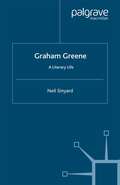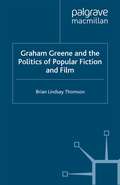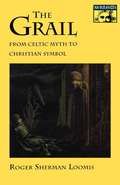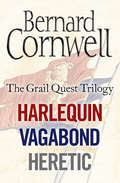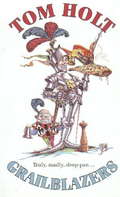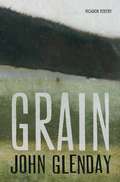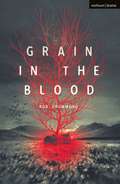- Table View
- List View
Graham Greene: An Approach to the Novels
by Robert HoskinsThis study reveals Greene in a dual role as author, one who projects literary experience into his view of life and subsequently projects both his experience and its "literary" interpretation into his fiction; and it defines two phases of Greenes novels through the changing relationship between writer and protagonists. The first phase progresses from acutely sensitive, self-divided young men somewhat like the young Greene to embittered, alienated characters ostensibly at great distance from their creator. The second phase (1939) includes a series of "portraits of the artist" through which Greene confronts more directly the tensions and conflicts of his private life.
Graham Greene: An Approach to the Novels (Reference Library Of The Humanities #Vol. 1684)
by Robert HoskinsThis study reveals Greene in a dual role as author, one who projects literary experience into his view of life and subsequently projects both his experience and its "literary" interpretation into his fiction; and it defines two phases of Greenes novels through the changing relationship between writer and protagonists. The first phase progresses from acutely sensitive, self-divided young men somewhat like the young Greene to embittered, alienated characters ostensibly at great distance from their creator. The second phase (1939) includes a series of "portraits of the artist" through which Greene confronts more directly the tensions and conflicts of his private life.
Graham Greene (Modern Novelists)
by Neil McEwanThis book sets out the most significant aspects of Graham Greene's achievement as a novelist of ideas and commitments and as a great storyteller and artist in prose. Readings of the major novels illustrate the development of Greene's attitudes and sympathies. The aim is to show how enjoyable and rewarding his work can be for 'agnostics' as well as for those who share Greene's allegiances. Special attention is paid to the flair for comedy which contributes even to the darkest stories, and to the craft of writing which has made Greene a best-seller as well as one of the most respected novelists of our time.
Graham Greene: A Literary Life (Literary Lives)
by Neil SinyardA new title in Palgrave Macmillan's Literary Lives series, this is a biographical narrative of Graham Greene's literary career. Among other things, it explores his motives for writing; the literary and cinematic influences that shaped his work; his writing routine and the importance of his childhood experience. Greene was elusive and enigmatic, and this book teases out the fiction from his autobiographies, the autobiography from his fictions, sharing Paul Theroux's view that you may not know Greene from his face or speech 'but from his writing, you know everything.'
Graham Greene and the Politics of Popular Fiction and Film
by B. ThomsonOne of the most popular, respected and controversial writers of the twentieth century, Greene's work has still attracted relatively little scholarly comment. Thomson charts the intricate dance between his novels and screenplays, his many audiences, and an intellectual establishment reluctant to identify the work of a popular writer as 'literature'.
Graham Greene: Political Writer
by Michael G. BrennanGraham Greene remarked that 'politics are in the air we breathe, like the presence or absence of a God' (The Other Man). This study is the first to provide a detailed consideration of the impact of his political thought and involvements on his writings both fictional and factual. It also offers the first detailed consideration of Greene's involvements in espionage and British intelligence from the 1920s until the late-1980s. It incorporates material not only from his major fictions but also from his prolific journalism, letters to the press, private correspondence, diaries and working manuscripts and typescripts, as well as consideration of the diverse political involvements and writings of his extended family network. It shows how the full range of Greene's writings was inspired and underpinned by his fascination with the essential human duality of political action and religious belief, coupled with an insistent need as a writer to keep the political personal.
Graham Greene’s Conradian Masterplot: The Arabesques of Influence
by Robert PendletonFrom The Man Within (1929) to The Captain and the Enemy (1988), Graham Greene engaged in a lifelong dialogue with Joseph Conrad's political, psychological and melodramatic fictions. Repressing Conrad's political anxieties, his early work displaces the protagonist's existential dilemma into the form of the thriller or - alternatively -the 'Catholic' novel. After The Quiet American (1955), however, Greene's novels return to politics, introducing comic variations which transform Conrad's 'masterplot' into a mixed genre uniquely his own, a process charted in this book, the first full-length study of the subject.
Graham Greene's Journeys in Spain and Portugal: Travels with My Priest
by Carlos Villar FlorIn the 1970s and 1980s, Graham Greene adopted the yearly habit of touring Spain and Portugal in the company of his Spanish friend, the priest and university professor Leopoldo Durán. The most outstanding fruit of these trips, almost always in summer, was the inspiration for his major Hispanic novel, Monsignor Quixote (1982), a celebration of friendship above ideological, political, or religious differences, incorporating allusions to Cervantes' famous comic novel within a critical vision of post-Franco Spain. Graham Greene's Journeys in Spain and Portugal: Travels with My Priest reconstructs each of Greene's trips through the Iberian Peninsula between 1976 and 1989, detailing their preparations, itineraries, anecdotes, companions, topics of conversation, and often surprising repercussions. Carlos Villar Flor outlines the trips' biographical importance and fills numerous gaps of documented information on this final phase of Greene's life. His detailed inquiry into Greene's Iberian adventures with Durán also helps us better to understand the genesis and resonances of Monsignor Quixote, which over time became Greene's favourite of his own novels, and the subsequent television adaptation. The book also addresses incidents and aspects that, for one reason or another, never emerged in Durán's own account of their travels together, Graham Greene: Friend and Brother (1994). These include the possible motivations for Greene's first visit to Spain, related to his role as an informant for MI6; the mysterious visits to an old English lady located in Sintra; the writer's attempts in the early 1980s to establish links with Spanish socialists; or the fascinating story of a Spanish nobleman's suspicious proposal to create a Greene Foundation. Ultimately, Greene's trips to Spain and Portugal appear as more layered and intriguing than Durán's account suggests, whilst Durán himself emerges aptly as a complex and quixotic figure—as much the protagonist of this book as Greene.
Graham Greene's Journeys in Spain and Portugal: Travels with My Priest
by Carlos Villar FlorIn the 1970s and 1980s, Graham Greene adopted the yearly habit of touring Spain and Portugal in the company of his Spanish friend, the priest and university professor Leopoldo Durán. The most outstanding fruit of these trips, almost always in summer, was the inspiration for his major Hispanic novel, Monsignor Quixote (1982), a celebration of friendship above ideological, political, or religious differences, incorporating allusions to Cervantes' famous comic novel within a critical vision of post-Franco Spain. Graham Greene's Journeys in Spain and Portugal: Travels with My Priest reconstructs each of Greene's trips through the Iberian Peninsula between 1976 and 1989, detailing their preparations, itineraries, anecdotes, companions, topics of conversation, and often surprising repercussions. Carlos Villar Flor outlines the trips' biographical importance and fills numerous gaps of documented information on this final phase of Greene's life. His detailed inquiry into Greene's Iberian adventures with Durán also helps us better to understand the genesis and resonances of Monsignor Quixote, which over time became Greene's favourite of his own novels, and the subsequent television adaptation. The book also addresses incidents and aspects that, for one reason or another, never emerged in Durán's own account of their travels together, Graham Greene: Friend and Brother (1994). These include the possible motivations for Greene's first visit to Spain, related to his role as an informant for MI6; the mysterious visits to an old English lady located in Sintra; the writer's attempts in the early 1980s to establish links with Spanish socialists; or the fascinating story of a Spanish nobleman's suspicious proposal to create a Greene Foundation. Ultimately, Greene's trips to Spain and Portugal appear as more layered and intriguing than Durán's account suggests, whilst Durán himself emerges aptly as a complex and quixotic figure—as much the protagonist of this book as Greene.
Graham Greene's Narrative Strategies: A Study of the Major Novels
by M. RostonIn Narrative Strategies Roston focuses upon the Greene's texts themselves and their manipulation of reader response, highlighting the innovative strategies that Greene developed to cope with the mid-century invalidation of the traditional hero. The result is a stimulating new reading of the major novels.
The Grail: From Celtic Myth to Christian Symbol
by Roger Sherman LoomisThe medieval legend of the Grail, a tale about the search for supreme mystical experience, has never ceased to intrigue writers and scholars by its wildly variegated forms: the settings have ranged from Britain to the Punjab to the Temple of Zeus at Dodona; the Grail itself has been described as the chalice used by Christ at the Last Supper, a stone with miraculous youth-preserving virtues, a vessel containing a man's head swimming in blood; the Grail has been kept in a castle by a beautiful damsel, seen floating through the air in Arthur's palace, and used as a talisman in the East to distinguish the chaste from the unchaste. In his classic exploration of the obscurities and contradictions in the major versions of this legend, Roger Sherman Loomis shows how the Grail, once a Celtic vessel of plenty, evolved into the Christian Grail with miraculous powers. Loomis bases his argument on historical examples involving the major motifs and characters in the legends, beginning with the Arthurian legend recounted in the 1180 French poem by Chrtien de Troyes. The principal texts fall into two classes: those that relate the adventures of the knights in King Arthur's time and those that account for the Grail's removal from the Holy Land to Britain. Written with verve and wit, Loomis's book builds suspense as he proceeds from one puzzle to the next in revealing the meaning behind the Grail and its legends.
The Grail: From Celtic Myth to Christian Symbol (Mythos: The Princeton/Bollingen Series in World Mythology (PDF) #46)
by Roger Sherman LoomisThe medieval legend of the Grail, a tale about the search for supreme mystical experience, has never ceased to intrigue writers and scholars by its wildly variegated forms: the settings have ranged from Britain to the Punjab to the Temple of Zeus at Dodona; the Grail itself has been described as the chalice used by Christ at the Last Supper, a stone with miraculous youth-preserving virtues, a vessel containing a man's head swimming in blood; the Grail has been kept in a castle by a beautiful damsel, seen floating through the air in Arthur's palace, and used as a talisman in the East to distinguish the chaste from the unchaste. In his classic exploration of the obscurities and contradictions in the major versions of this legend, Roger Sherman Loomis shows how the Grail, once a Celtic vessel of plenty, evolved into the Christian Grail with miraculous powers. Loomis bases his argument on historical examples involving the major motifs and characters in the legends, beginning with the Arthurian legend recounted in the 1180 French poem by Chrtien de Troyes. The principal texts fall into two classes: those that relate the adventures of the knights in King Arthur's time and those that account for the Grail's removal from the Holy Land to Britain. Written with verve and wit, Loomis's book builds suspense as he proceeds from one puzzle to the next in revealing the meaning behind the Grail and its legends.
Grail (The Sacred Band Trinity #3)
by James MacTavishThe Sacred Band Trinity concludes with the remaining Red Dragon members in a race against time to prevent Lady Morgan Worthington and her White Dragon acolytes fulfilling an ancient prophecy that would reshape the world. Luke Allen possesses the fabled blade of Excalibur, but must understand its true nature in order to wield it, whereas younger brother Adam conflicted by grief and duty as a Sacred Band warrior. The mysteries of King Arthur and the Round Table unfold before them both, and to prevent centuries worth of history repeating once more, they and their allies must stand and confront the power of the Trinity - the foundation of many faiths - and be prepared to do whatever is necessary to protect those they love. Even if this means making the ultimate sacrifices.
Grail Knight: Number 5 in series (Outlaw Chronicles #5)
by Angus DonaldA home burnedWhen past crimes resurface, Sir Alan Dale, loyal lieutenant of the Earl of Locksley - better known as the murderous thief Robin Hood - faces terrible vengeance at the hands of those that he and his master have wronged.A family threatenedWith his beloved wife on her deathbed, Sir Alan must seek salvation by following Robin into the lair of their enemy, the mysterious leader of a band of renegade Templars, on the trail of the most precious object in the world: the Holy Grail.Only a miracle can save themAs vengeful Templars hound Robin and his men across England and France, deals done with mighty lords turn to bloody battle. The companions must find the Cup of Christ before they face certain destruction.Myth, mayhem and masterly storytelling meet in the astounding new epic from the bestselling author of Outlaw and Holy Warrior
The Grail Murders (Tudor Mysteries, Book 3): A thrilling Tudor mystery of murder, intrigue and hidden treasure
by Paul DohertyThe search for hidden treasure brings Rodger Shallot face to face with murder...In Paul Doherty's The Grail Murder, Richard Shallot's third journal, he must pit his wits against the terrifying and mysterious Templars. Perfect for fans of Ellis Peters and C.J. Sansom.In 1522 the rogue Roger Shallot and his sober-sided master Benjamin Daunbey are sent for by Cardinal Wolsey. Stafford, Duke of Buckingham, has been arrested for treason and Benjamin and Roger are made to witness his bloody execution. The true reason for Buckingham's downfall soon becomes apparent: he was searching at Templecombe Manor and Glastonbury Abbey in Somerset for two precious relics - the Holy Grail and Excalibur, the sword of King Arthur.Benjamin and Shallot are ordered to Templecombe, accompanied by the leaders of King Henry VIII's dreaded secret service, the Agentes in Rebus, to find these relics for the King. They must pit their wits against the Templars, a secret organisation plotting against the Tudors, of which Buckingham may have been a part and who may still have a member of their society close to the crown.The difficulties that wily Shallot - running true to his boast of possessing the fastest legs and quickest wits in Christendom - has to face soon make their presence felt: a duel, blackmail, the curses of a witch, the grisly hand of glory, decapitated heads, mysterious fires - and silent murder in the eerie Templar chapel.What readers are saying about The Grail Murders: 'This book had it all, locked room murders, a mysterious country manor house, an abbey, Templar conspiracy and Arthurian folklore - excellent!''Fascinating... historical mysteries brought to life with lots of accurate historical facts''Excellent story. Always enjoyed the Shallot stories, he is a lovable rogue'
The Grail Quest Books 1-3: Harlequin, Vagabond, Heretic
by Bernard CornwellBernard Cornwell’s bestselling Grail Quest Trilogy in one complete eBook for the first time. Follow the famed archer Thomas of Hookton as he avenges his father’s death and retrieves a stolen relic.
The Grail Tree (Lovejoy)
by Jonathan GashLovejoy has heard of more nutters who have claimed to be in possession of the one, true Holy Grail than he has had hot dinners. He's not too impressed with the eccentric clergyman making the latest claim - especially when the good vicar turns out to be one of the finest forgers Lovejoy has ever met. But when the vicar and his lady companion end up dead it becomes clear that someone else is after the old man's artefact. To solve the mystery and protect a precious piece of history, Lovejoy puts his life on the line and acquires a surprising new partner...
Grailblazers
by Tom HoltFifteen hundred years have passed and the Holy Grail is still missing, presumed ineffable. The knights have dumped the quest and now deliver pizzas, while the sinister financial services of the lost kingdom of Atlantis threatens the universe with fiscal Armageddon.
Grailstone Gambit
by James AxlerA deadly truth… When Victor Holland comes flying out of the night, he runs straight into the path of Catherine Weaver’s car. Having uncovered a terrifying secret which leads all the way to Washington, Victor is running for his life – and from the men who will go to any lengths to silence him.
Grain
by John GlendayThough John Glenday has long been admired for his lyrically delicate and emotionally powerful poetry, he has remained something of a well-kept secret. His third collection, Grain, makes his singular talent available to a wider audience. Sometimes Glenday’s poems are forcefully direct; sometimes they are so quiet they feel as if they were composed within a capacious listening, as a form of secular prayer. Glenday’s seamless lyric can also disguise some wild and surreal tales: the Beauty and the Beast told in reverse, a bizarre list of new saints, or a can of peaches waiting for the invention of the tin-opener. However, the lasting impression is of a genuinely spiritual poet, one with the ability to turn every earthly detail towards the same clear light. Grain announces Glenday as an essential voice in contemporary poetry.
Grain in the Blood (Modern Plays)
by Rob DrummondTwelve years ago, from the mouth of a great sacrifice, a child was born. And they called her Autumn. Isaac returns to his family home with a chance to atone for the terrible mistake that claimed his childhood.Autumn is a little girl whose time is running out. With three sleeps left before her birthday, she can only hope for a miracle, or an unexpected act of selflessness. Her grandmother, Sophia, brings them together in a desperate attempt to save her family, at any cost.Set against the eerie backdrop of an isolated rural community and steeped in the folklore of the harvest, Grain in the Blood is a noir-ish thriller exploring a timely moral dilemma: how much are we prepared to sacrifice for the greater good?The play received its world premiere at the Tron Theatre, Glasgow, on 18 October 2016, before opening at the Traverse Theatre, Edinburgh, on 1 November 2016.
Grain in the Blood (Modern Plays)
by Rob DrummondTwelve years ago, from the mouth of a great sacrifice, a child was born. And they called her Autumn. Isaac returns to his family home with a chance to atone for the terrible mistake that claimed his childhood.Autumn is a little girl whose time is running out. With three sleeps left before her birthday, she can only hope for a miracle, or an unexpected act of selflessness. Her grandmother, Sophia, brings them together in a desperate attempt to save her family, at any cost.Set against the eerie backdrop of an isolated rural community and steeped in the folklore of the harvest, Grain in the Blood is a noir-ish thriller exploring a timely moral dilemma: how much are we prepared to sacrifice for the greater good?The play received its world premiere at the Tron Theatre, Glasgow, on 18 October 2016, before opening at the Traverse Theatre, Edinburgh, on 1 November 2016.
The Grain Kings: The Chalk Giants, Kiteworld, The Grain Kings
by Keith Roberts'We reap and we thresh; grain for half the world. We are the Grain Kings raised of old.'They call them the Grain Kings. Gigantic mechanical monarchs of the wheat-bearing plains that were once the frozen Alaskan wastes. Whole eco-systems in themselves, they can supply the food so desperately needed by the teeming millions of our overpopulated planet. But even now, as the whole world waits in hungry suspense, the great powers battle for control of the prairies and two competing combine harvesters find they are heading on a course of collision. A collision with catastrophic consequences - not only for the hundreds of crewmen aboard each massive machine but for the future survival of all mankind.


